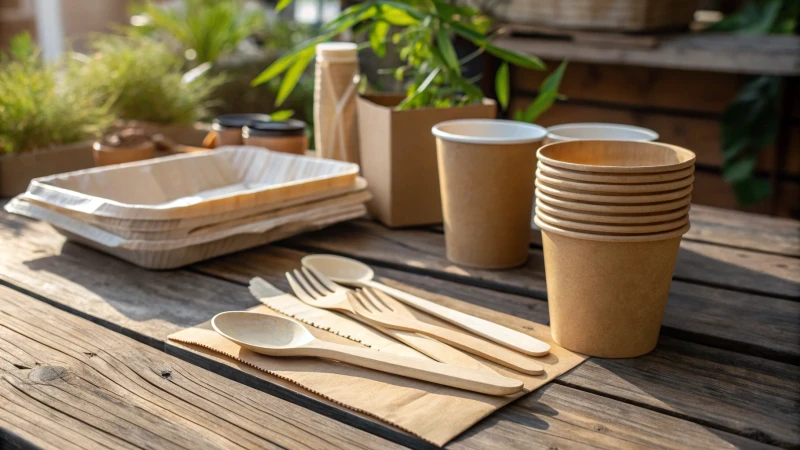
Picture this: you're at a picnic, and you’re using a wooden fork that feels as sturdy as your grandma’s old oak dining table. Ever wondered why?
Choosing the right raw materials is like picking the perfect ingredients for a recipe—it's crucial. High-quality, sustainably-sourced wood not only boosts the durability of disposable wooden cutlery but also minimizes its environmental footprint, offering a greener alternative to plastic.
I remember the first time I really thought about the materials behind everyday items. It hit me while sorting through kitchen drawers, tossing out flimsy plastic utensils that snapped more than they scooped. Switching to wooden cutlery seemed like a no-brainer, but then I learned not all wood is created equal.
You see, while choosing wooden cutlery is a fantastic stride towards sustainability, it’s the type of wood that truly makes a difference. Some woods, like birch and bamboo, are champions in both durability and eco-friendliness. They stand up to repeated use, break down naturally, and don’t demand excessive resources to produce. Moreover, ethical sourcing is critical—just as I'd want my coffee beans fair-trade, I insist on wood sourced responsibly. It’s about ensuring that our choices today leave a world worth inheriting tomorrow.
So next time you pick up a wooden fork, maybe at an outdoor wedding or your favorite café, know that its sturdiness and sustainability are rooted in the raw material choices made long before it reached your hand.
Bamboo is more sustainable than birch for wooden cutlery.True
Bamboo grows faster and regenerates quickly, making it more sustainable.
All types of wood offer equal durability for cutlery.False
Different woods vary in density and strength, affecting durability.
What Makes Wood Ideal for Durable and Sustainable Cutlery?
Ever wondered why some wooden cutlery lasts longer and feels better than others?
Bamboo, maple, and teak are the top woods for durable, sustainable cutlery. These options provide strength and wear resistance, sourced from sustainable forests to minimize environmental impact.
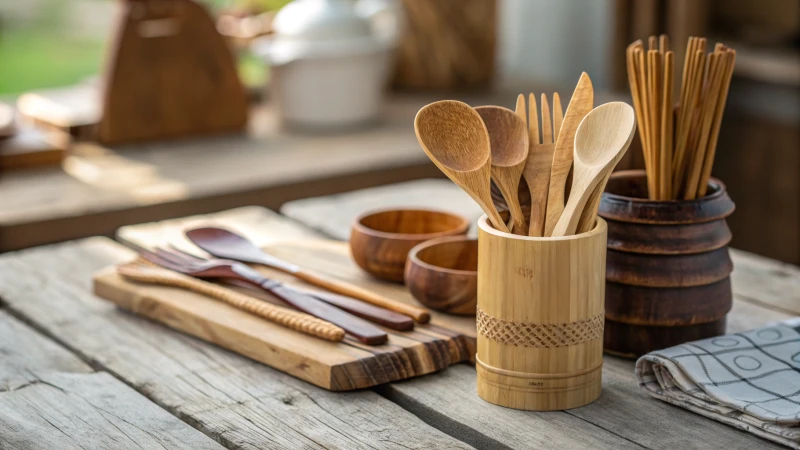
Exploring Popular Wood Choices for Cutlery
When it comes to choosing wood for cutlery, I’ve found that it’s all about striking the right balance between durability and sustainability1. Let me share a bit of my journey into this. Once, while shopping for wooden utensils, I realized how much I wanted something that wouldn’t just last but also had a story rooted in eco-friendly practices. Here’s what I discovered about some of the best options out there:
-
Bamboo: Imagine a material that grows as fast as your enthusiasm for sustainable living. Bamboo is exactly that—strong, lightweight, and incredibly renewable. I remember being amazed at how my bamboo chopsticks remained smooth after countless uses.
-
Maple: If you’re like me and love the idea of cutlery that feels sturdy and reliable, maple might be your go-to. Its fine texture and resilience against splitting are impressive, making it a choice you can depend on.
-
Teak: The first time I used teak cutlery, I was struck by its natural elegance. With its inherent water-resistant oils, teak is perfect for those of us who frequently wash our utensils.
Wood Characteristics Comparison
| Wood Type | Durability | Sustainability | Grain Pattern |
|---|---|---|---|
| Bamboo | High | Very High | Uniform |
| Maple | Very High | High | Fine |
| Teak | High | Medium | Straight |
Sourcing and Certification
I’ve learned the hard way that not all wood is created equal when it comes to sustainability. It's vital to source wood from certified suppliers2 who adhere to strict environmental standards. Certifications like FSC (Forest Stewardship Council) ensure responsible forestry practices, which gives me peace of mind knowing I'm making an environmentally sound choice.
Considerations for Customization
Personalizing your wooden cutlery can be a fun way to reflect your unique style or brand identity. Whether through laser engraving or using natural dyes, customization can enhance both the aesthetic appeal and the eco-friendly branding strategies3 of your cutlery.
Ultimately, each type of wood offers distinct advantages. It all boils down to finding the right balance between environmental impact, functionality, and your personal taste or brand preference. By understanding these elements, we can make informed decisions that not only align with sustainability goals but also elevate our dining experiences.
Bamboo cutlery is more sustainable than teak.True
Bamboo grows rapidly and is highly renewable, unlike teak.
Maple has a lower durability rating than bamboo.False
Maple is a dense hardwood with very high durability.
How Does Sourcing Impact the Environmental Benefits of Wooden Utensils?
Ever wondered if the story behind your wooden spoon could change the world? The source of its wood could be the key.
Sourcing directly impacts the environmental benefits of wooden utensils by affecting resource sustainability, carbon footprint, and forest conservation. Choosing ethically sourced materials minimizes ecological disruption, enhancing these utensils' eco-friendly appeal.
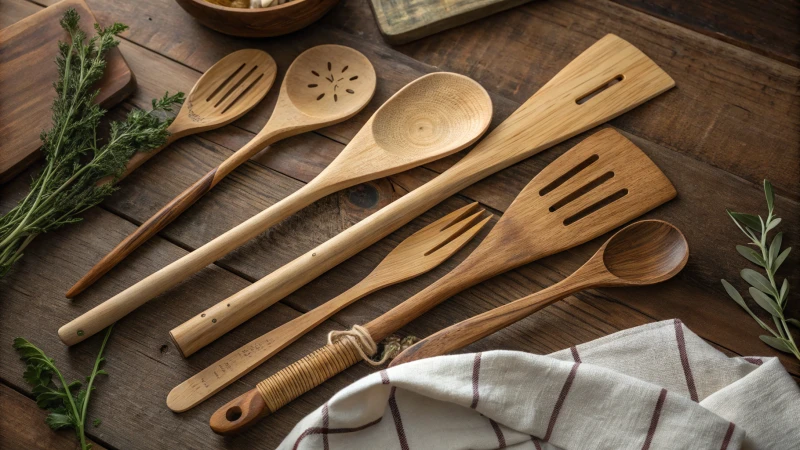
The Importance of Sustainable Wood Sources
I remember the first time I held a beautifully crafted wooden spoon, thinking how this simple tool connected me to nature. It's not just about the elegance of wooden utensils but where the wood comes from that truly matters. Sustainable sourcing practices4 ensure that raw materials are harvested responsibly, preserving forest ecosystems. For instance, using FSC-certified wood guarantees that forests are managed ethically, promoting biodiversity.
Carbon Footprint Considerations
When I shop for wooden utensils, I always think about their journey. Did they travel across continents or were they made just around the corner? Transportation and processing can significantly add to the carbon footprint. By sourcing locally or from regions with efficient logistics, companies can reduce emissions associated with long-distance shipping. A comparative analysis might include:
| Source | Average Distance (km) | Emissions (kg CO2/tonne) |
|---|---|---|
| Local | 50 | 20 |
| International | 5000 | 300 |
Forest Conservation and Ethical Practices
I can't help but feel a sense of responsibility when choosing products. Ethical sourcing supports forest conservation by ensuring that logging maintains ecosystem health. This means avoiding deforestation in critical areas and supporting reforestation5 efforts. Using reclaimed or recycled wood further enhances sustainability.
Impact on Local Communities
Whenever I purchase sustainably sourced products, I think about the people behind them. Sourcing wood responsibly also affects local communities. Fair trade and ethical practices ensure workers are compensated fairly and communities benefit economically from sustainable harvesting. Partnerships with local communities can foster economic growth while preserving natural resources.
To explore more about community impact and fair trade, consider exploring related topics6. This approach not only boosts the product's eco-credentials but also contributes positively to socio-economic factors.
Certification and Compliance
I always look for certifications as a badge of trust. Certifications like FSC (Forest Stewardship Council) or PEFC (Programme for the Endorsement of Forest Certification) play a pivotal role in verifying that wood is sourced sustainably. These certifications ensure compliance with international standards for sustainability and ethical forestry practices.
By understanding these elements, stakeholders can make informed decisions that enhance the environmental benefits of using wooden utensils.
FSC-certified wood guarantees ethical forest management.True
FSC certification ensures forests are managed ethically, promoting biodiversity.
International sourcing of wood reduces carbon emissions.False
International sourcing increases emissions due to long-distance shipping.
What Certifications Ensure Sustainable Wooden Cutlery?
I remember when I first started caring about sustainability in my daily life. Wooden cutlery seemed like an obvious choice, but how could I be sure it was truly eco-friendly? That’s when I discovered certifications.
Certifications like FSC and PEFC guarantee that wooden cutlery is sourced from sustainably managed forests. These certifications ensure eco-friendly practices, preventing illegal logging and promoting conservation.
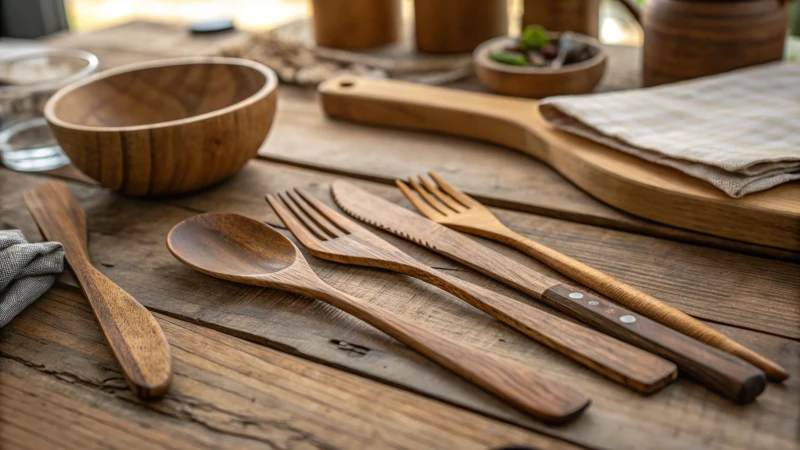
Understanding Key Certifications for Wooden Cutlery
Let me share a bit of what I've learned on my journey to find genuinely sustainable wooden cutlery. It turns out, there are a few key certifications that really stand out:
-
Forest Stewardship Council (FSC): When I saw this label for the first time, it was like finding a trusted friend in the forest of eco-labels. The FSC certification means the wood comes from forests that meet rigorous environmental, social, and economic standards. So, when you see the FSC label7, you know you're supporting sustainable forestry.
-
Programme for the Endorsement of Forest Certification (PEFC): Similar to FSC, PEFC caught my attention because it promotes sustainable forest management. Choosing PEFC-certified products8 reassures me that I'm supporting responsible sourcing.
| Certification | Key Features |
|---|---|
| FSC | Protects biodiversity, respects indigenous rights |
| PEFC | Encourages local engagement, ensures chain of custody |
The Role of Sustainable Sourcing in Certification
What I've come to realize is that certifications depend heavily on responsible sourcing practices. Companies must trace their materials back to their sustainable origins, which is a huge relief for anyone worried about illegal logging or unsustainable practices. This kind of transparency is so important for maintaining consumer trust9.
Additionally, these certifications often involve:
- Regular audits to keep companies in check
- Community involvement in forestry decisions, which I think is fantastic
- Promoting forest regeneration and biodiversity—because who doesn't want healthier forests?
Challenges and Considerations
But here's the thing: while certifications give us peace of mind, they're not without their challenges. For example, not all regions have easy access to certified wood, which can drive up costs. Businesses have to balance these economic factors10 with their sustainability goals.
Plus, it's important to remember that while certifications show adherence to standards, they're not a guarantee of perfection. That's why I believe consumers and businesses alike should stay informed about the broader impacts of their choices. After all, every little bit helps in our shared journey toward sustainability.
FSC certification guarantees sustainable wooden cutlery.False
FSC certification ensures responsible sourcing but doesn't guarantee perfection.
PEFC promotes local engagement in forestry decisions.True
PEFC encourages community involvement in sustainable forest management.
What Are the Potential Disadvantages of Using Wooden Cutlery?
Switching to wooden cutlery might seem like an easy win for the environment, but it comes with its own set of challenges. Let me walk you through what I discovered when I made the change.
Wooden cutlery's main drawbacks include hygiene concerns due to moisture absorption, less durability compared to metal, and environmental impacts linked to wood sourcing. Weigh these factors carefully before choosing wooden cutlery.
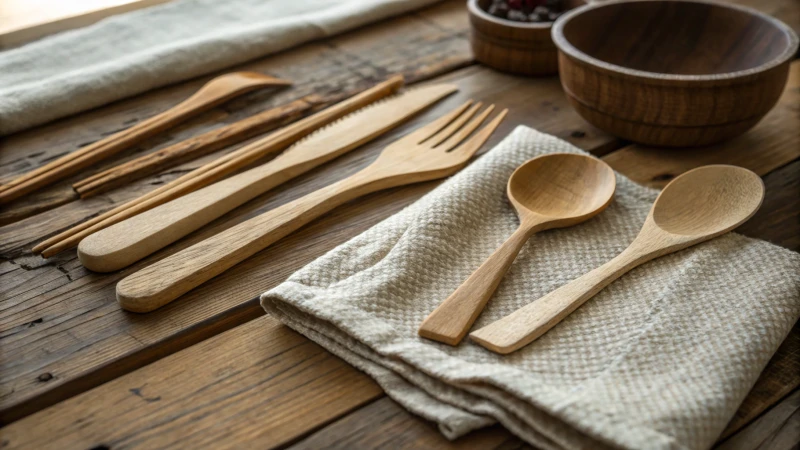
Hygiene Concerns with Wooden Cutlery
When I first decided to switch to wooden cutlery, I didn't anticipate the hygiene challenges that would come with it. Unlike metal utensils, wooden ones can absorb moisture, making them a potential hotspot for bacteria if not cleaned and dried properly. I learned this the hard way when I noticed a funky smell coming from my drawer. In settings like restaurants or hospitals, where sanitation is non-negotiable, proper maintenance becomes even more crucial. Ensuring proper maintenance11 can help mitigate these risks.
Durability and Performance
I have to admit, the rustic charm of wooden cutlery was irresistible. But after a few hearty meals, I started noticing splinters and breaks. While they looked great on the table, their durability didn’t quite match up to my trusty metal or even hard plastic utensils. Frequent use, especially during family gatherings or parties, can lead to these issues, which isn't ideal. Comparing the strength of materials12 can offer more insights into what suits your needs best.
| Material Type | Durability Rating | Typical Usage |
|---|---|---|
| Wooden | Moderate | Casual dining |
| Metal | High | All-purpose |
| Plastic | Variable | Disposable |
Environmental Impact of Wood Sourcing
Initially, I felt good about my choice from an environmental standpoint. However, as I dug deeper, I realized that not all wooden cutlery is created equal. The environmental benefits can be negated if the wood is sourced unsustainably. This prompted me to look for certifications and reliable sources when choosing my products. It's essential to check for certifications and sourcing13 to ensure that the cutlery truly supports sustainability.
Cost Implications
Switching to wooden cutlery wasn't just an emotional investment; it hit my wallet too. Wooden options, especially those made from high-quality or certified sustainable wood, can be pricier than their plastic counterparts. This was an important factor for me to consider, especially with a budget in mind. Evaluating cost versus benefit14 is essential before making a decision.
Aesthetic and Customization Limitations
Wooden cutlery undeniably brings a rustic charm to any table setting, but I found it sometimes clashed with more modern or luxury aesthetics. If you're a business looking to align with a high-end brand image, these limitations can be significant. Assessing how design impacts brand15 is crucial for any marketing strategy.
Considering these aspects helped me understand the broader picture beyond the eco-friendly appeal of wooden cutlery. By evaluating factors such as hygiene, durability, environmental impact, cost, and aesthetics, I could make more informed decisions that aligned with both my values and operational needs.
Wooden cutlery is more durable than metal.False
Metal cutlery generally outlasts wooden ones due to its strength.
Sustainable wood sourcing is crucial for eco-friendly benefits.True
Unsustainable wood negates the environmental advantages of wooden cutlery.
Conclusion
Choosing high-quality, sustainably-sourced wood for disposable wooden cutlery enhances durability and minimizes environmental impact, making it a superior alternative to plastic utensils.
-
Bamboo is a rapidly renewable resource, making it an excellent sustainable choice for eco-conscious consumers. ↩
-
FSC certification ensures responsible forestry practices, safeguarding ecosystems and supporting sustainable product sourcing. ↩
-
Explore how eco-friendly materials can enhance brand image by appealing to environmentally conscious consumers. ↩
-
Learn about sustainable sourcing practices to ensure the environmental benefits of wooden utensils are maximized. ↩
-
Discover how reforestation efforts enhance sustainability in wood sourcing. ↩
-
Explore how fair trade practices benefit local communities economically and environmentally. ↩
-
Explore the meaning and benefits of FSC certification in ensuring sustainable forestry practices. ↩
-
Learn about PEFC's criteria for forest management and its impact on sustainability. ↩
-
Understand how certifications build trust with eco-conscious consumers. ↩
-
Discover how costs and availability influence sourcing decisions for sustainable products. ↩
-
Learn effective cleaning methods to prevent bacterial growth on wooden cutlery. ↩
-
Understand how different materials stack up in terms of strength and longevity. ↩
-
Identify certifications that guarantee environmentally friendly wood sourcing. ↩
-
Weigh the financial implications of switching to wooden cutlery. ↩
-
Explore how cutlery design can enhance or detract from a brand's image. ↩

